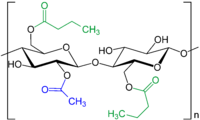Cellulose acetate butyrate
 Simplified representation of cellulose acetate butyrate with acetyl (blue) and butyryl (green) groups highlighted. The distribution of these ester groups can vary within the polymer chain.
| |
| Identifiers | |
|---|---|
| ECHA InfoCard | 100.130.734 |
CompTox Dashboard (EPA)
|
|
| Properties | |
| Appearance | White solid[1] |
| Odor | Odorless[1] |
| Melting point | 127–205 °C (261–401 °F; 400–478 K)[1] |
| Negligible[1] | |
Except where otherwise noted, data are given for materials in their standard state (at 25 °C [77 °F], 100 kPa).
| |
Cellulose acetate butyrate (CAB) is a mixed ester thermoplastic derivative of cellulose acetate that contains both acetate and butyrate functional groups. It has improved weathering resistance and lower moisture absorption compared to cellulose acetate. The exact properties of a CAB compound is determined by the composition of butyrate vs acetate functional groups.[2]
CAB is commonly used as a binder or additive in coatings.[3]
References[edit]
- ^ a b c d "Safety Data Sheet". fishersci.se.
- ^ "Cellulose Acetate Butyrate, Eastman - ChemPoint". www.chempoint.com. Retrieved 2021-05-02.
- ^ "CAB". polymerdatabase.com. Retrieved 2021-05-02.
